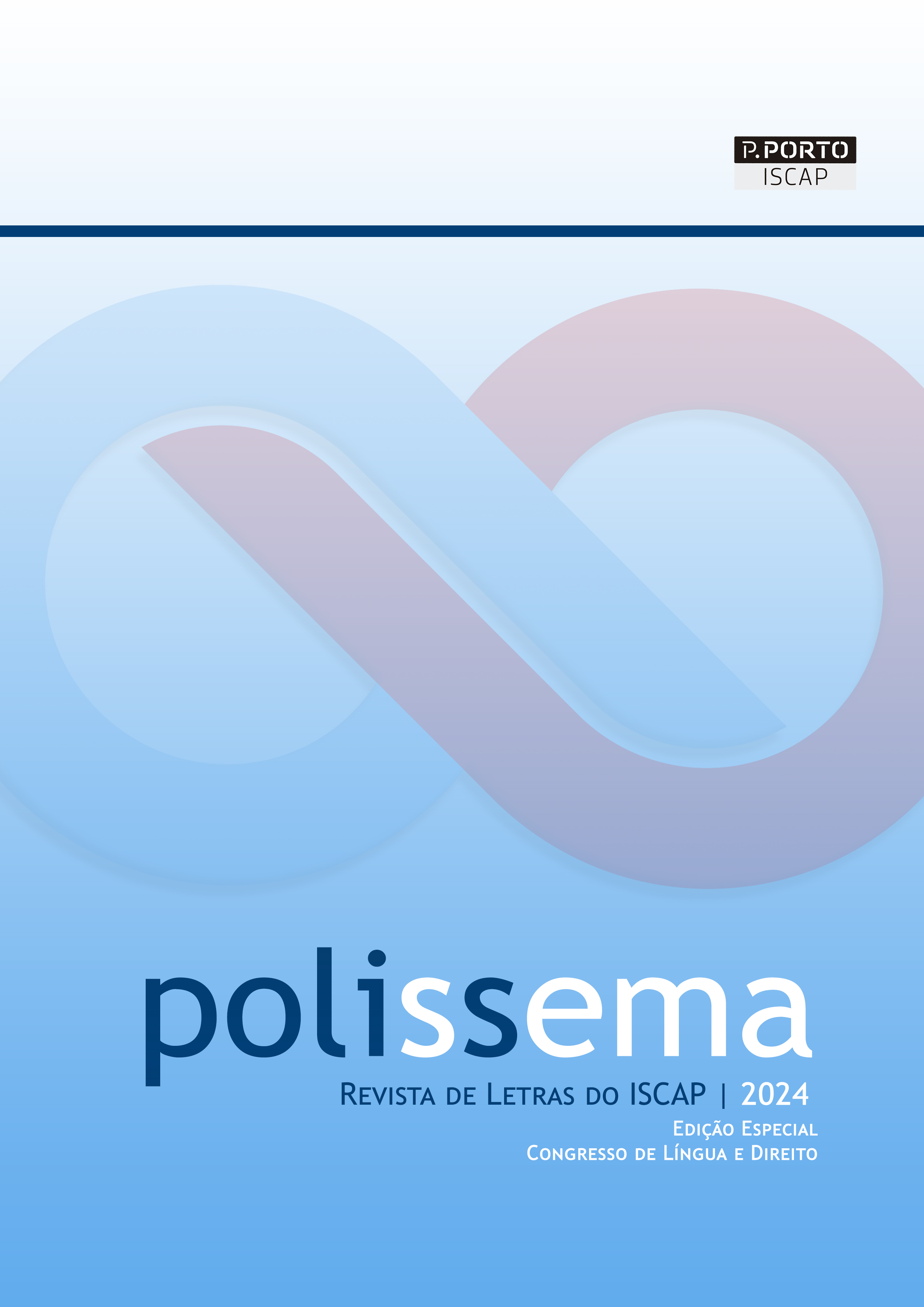A CALIFORNIAN-IBERIAN APPROACH ON TECHNOLOGICAL ADOPTION AND AUTOMATION IN COURTROOMS: THE CASE OF VOICE WRITING
DOI :
https://doi.org/10.34630/polissema.vi.5765Mots-clés :
voice writing, respeaking, captions, automation, artificial intelligenceRésumé
In the 1940s, voice writing began to be implemented in United States courts. It transcended the abilities of shorthand reporters, who had difficulties in following the fast pace of speakers, and introduced the first stenomask, a device designed to confine the voice of the reporter. Voice writing also used a microphone and a recording machine; a typist would afterwards reproduce the audio in written form. In the 2000s, voice recognition software was set at the end of the process, allowing for real-time transcripts. Compared to stenotyping, the technique has been competitive enough regarding quality and training requirements. Besides, it has represented greater accessibility for deaf and hard-of-hearing citizens, who can now read the captions a few seconds later. However, uncertainty has set in among these well‑remunerated professionals: is artificial intelligence (AI) a real threat for voice writers? And what is the situation in Spain and Portugal? This paper aims to describe the experience of voice writing in US courts, as it is an unfamiliar practice in the peninsular area, as well as to examine the challenges posed by AI to respeakers. It also analyses the procedural frameworks in Portugal, Spain and California that allow for or forbid the presence of such professionals. In addition, the analysis describes the opportunities for implementing voice writing and AI in the Iberian courtrooms, and the impact that AI might have in the United States.
Références
Briggs, J. & Kodnani, D. (2023). The Potentially Large Effects of Artificial Intelligence on Economic Growth. Global Economics Research. Goldman Sachs. http://tinyurl.com/2hb6ynky.
Cazzaniga, M. et al. (2024). Gen-AI: Artificial Intelligence and the Future of Work. IMF Staff Discussion Notes, SDN/2024/001. International Monetary Fund. http://tinyurl.com/3yn3dz4t.
Comisión Permanente del Consejo General del Poder Judicial (2017). Acuerdos adoptados en la sesión celebrada el día 19 de abril de 2017. http://tinyurl.com/ywh8ttan.
Council of the European Union (2024, 26 Jan.). Proposal for a Regulation of the European Parliament and of the Council laying down harmonised rules on artificial intelligence (Artificial Intelligence Act) and amending certain Union legislative acts – Analysis of the final compromise text with a view to agreement. Interinstitutional File no. 2021/0106(COD). http://tinyurl.com/vs6au8kn.
Etulle, R. D. et al. (2023). Investigating the listening and transcription performance in court: experiences from stenographers in Philippine courtrooms. Journal of Language and Pragmatics Studies, Vol. 2, Issue 2, pp. 100-111. http://tinyurl.com/4ay6ukp9.
Frey, C. B. & Osborne, M. (2013, reissued 2017). The Future of Employment: How Susceptible are Jobs to Computerization?. Technological Forecasting and Social Change, No. 114, pp. 254-280. http://tinyurl.com/3asj2ynw.
Josten, C. & Lordan, G. (2019). Robots at Work: Automatable and Non Automatable Jobs. IZA Discussion Papers, No. 12520. Institute of Labor Economics (IZA). http://tinyurl.com/7xetvpw7.
Lane, M.; Williams, M. & Broecke, S. (2023). The impact of AI on the workplace: Main findings from the OECD AI surveys of employers and workers. OECD Social, Employment and Migration Working Papers, No. 288. https://dx.doi.org/10.1787/ea0a0fe1-en.
National Court Reporters Association (2024). What is Court Reporting? http://tinyurl.com/3sejc4j9.
National Court Reporters Association (2022). Communication Access Realtime Translation (CART) in the Courtroom: Model Guidelines. http://tinyurl.com/2rskzk9a.
National Verbatim Reporters Association (2023). The Horace Webb Story. http://tinyurl.com/4yuanbad.
Proctor, K. (2023). Court Reporters Are Going to Look Different: Voice Writers Can Now Be Licensed As Court Reporters in California. Daily News – CEB Articles. http://tinyurl.com/mryf4be9.
Reino de España (1882). Real Decreto de 14 de septiembre de 1882 por el que se aprueba la Ley de Enjuiciamiento Criminal. Boletín Oficial del Estado. http://tinyurl.com/59n4r63f.
Reino de España (1985). Ley Orgánica 6/1985, de 1 de julio, del Poder Judicial. Boletín Oficial del Estado. http://tinyurl.com/mr39b5tm.
Reino de España (2000). Ley 1/2000, de 7 de enero, de Enjuiciamiento Civil. Boletín Oficial del Estado. http://tinyurl.com/3nu59nuk.
República Portuguesa (1987). Decreto-Lei nº 78/87, de 17 de fevereiro. Código de Processo Penal. Diário da República. http://tinyurl.com/aer2222e.
República Portuguesa (2013). Lei nº 41/2013, de 26 de Junho. Código de Processo Civil. Diário da República. http://tinyurl.com/4sy575s6.
Riesco del Río, J. (2023). El futuro del trabajo en la era de la automatización: reflexiones en torno a las habilidades en el mercado laboral. Cuadernos de la Fundación Primero de Mayo, No. 51. http://tinyurl.com/jp9469mb.
Romero-Fresco, P. (2009). More haste less speed: Edited versus verbatim respoken subtitles. Vigo International Journal of Applied Linguistics, No. 6, pp. 109-133. http://tinyurl.com/5d3mdrtt.
Rufino Morales, M. (2020). Estudio comparativo de métodos de transcripción para corpus orales: el caso del español. Revista Nebrija de Lingüística Aplicada a la Enseñanza de Lenguas, Vol. 14, No. 29, pp. 127-147. http://tinyurl.com/yhx43zyr.
State of California (2022). Assembly Bill No. 156. Chapter 569. California Legislative Information. http://tinyurl.com/yczffhcs.
State of California (2024). Code of Civil Procedure. Part 1: Of Courts of Justice. Title 4: Ministerial Officers of Courts of Justice. Chapter 3: Phonographic Reporters. California Legislative Information. http://tinyurl.com/mrxxcbm5.
State of California (2024). Business and Professions Code – BPC. Division 3: Professions and vocations generally. Chapter 13: Shorthand Reporters. Article 2: Application of Chapter. California Legislative Information. http://tinyurl.com/mrzd5bnk.
Szczygielska, M. et al. (2020). How to implement speech-to-text interpreting (live subtitling) in live events. Guidelines on making live events accessible. ILSA Project. http://tinyurl.com/29zb38fn.
Téléchargements
Publiée
Comment citer
Numéro
Rubrique
Licence
© POLISSEMA 2024

Ce travail est disponible sous licence Creative Commons Attribution - Pas d'Utilisation Commerciale - Pas de Modification 4.0 International.


